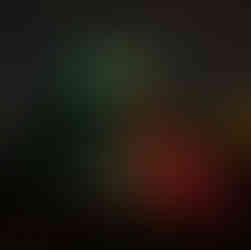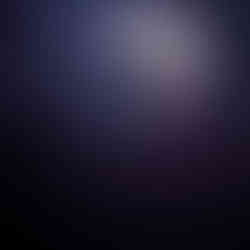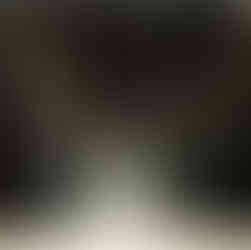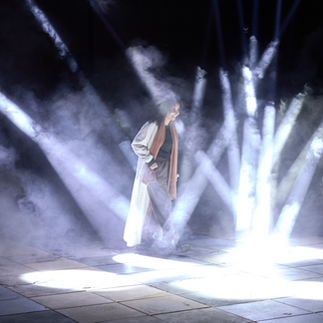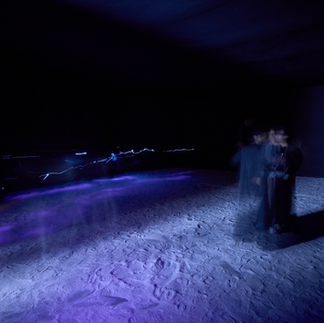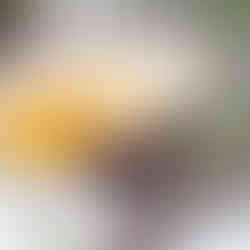Modern Rituals: Ceremonies Reinvented through Contemporary Public Art
- Artelier
- Apr 14
- 13 min read
Updated: Oct 3
The following review explores 6 local and international artists exhibited at Riyadh's annual light festival, Noor Riyadh 2024. During the exhibition, Artelier formed strong partnerships with notable artists such as SpY, Federico Acciardi, Daan Roosegaarde, A.A Murakami, Random International and Ayman Yossri Daydban.
This partnership made a deep impression, highlighting the powerful role artists can play in shaping future landscapes through public art. Artelier curator, Ella Forster, reflects on the artworks after her time working on the exhibition.
Introduction
From bustling city streets to quiet rural corners, ceremonies and rituals are woven into the fabric of everyday life, so familiar that we often overlook them. These practices, shaped by centuries of tradition, have their roots in sacred places, temples, altars, and communal gatherings, guided by religious texts, folklore, and oral storytelling. Emblems of local legacies, they reflect society’s deepest values and collective memories. But how do these practices evolve in the present day? What might modern rituals and ceremonies look like, and what roles do they play now?
In a world defined by rapid urbanisation, climate crisis, and the digital age, artists are reinventing the definition of ritual, not as a relic of the past, but as a living, evolving force. Through the lens of new-media art, we witness a new wave of ceremonies that seek to renew our sense of connection, to ourselves, to one another, and to the world around us. Rather than encouraging passive observation, artists are creating immersive installations that invite active engagement and participation from their audiences.
This article explores how six industry-leading contemporary artists from the world's largest light festival, Noor Riyadh 2024, reinterpret rituals in unexpected ways; through architecture, light, performance, and digital media.
From a glowing egg suspended above water to the artificial flicker of robotic fireflies, these works ask us to pause and consider: What defines a ritual today? Who creates it, and where does it take place? Bringing a fresh perspective, these artists are reshaping how we think about public spaces, turning often-overlooked places into spaces for reflection and meaning, reminding us that even in a hyper-connected, fast-moving world, we still crave ceremony, still seek meaning, and still perform rituals, often without even knowing it.
Jump straight to the artists:

Noor Riyadh
What do iconic contemporary artists like Yayoi Kusama, Dan Flavin, James Turrell, Carsten Höller, and Jeppe Hein have in common? They’ve all exhibited light-based art installations at Noor Riyadh, Saudi Arabia’s leading festival dedicated to the art of light. The word Noor, meaning “light” in Arabic, reflects the festival’s focus on immersive installations that combine cutting-edge technology, sound, and visuals to transform Riyadh’s public spaces. Successfully completing its fourth edition in 2024, the festival welcomed over 3 million visitors and showcased more than 60 artworks by artists from 18 countries.
The festival is part of Saudi Vision 2030, a government-led initiative to support the country’s arts and culture sector, creating opportunities rarely found in Europe today. With vast deserts and a fast-growing contemporary art scene, Saudi Arabia provides a unique canvas for large-scale installations previously thought impossible to achieve. For Noor Riyadh, artists had access to 75 miles of wadis and 126 acres of land, ranging from industrial zones to skyscrapers, heritage sites, and natural landmarks. Unlike the confined white-box galleries of Europe, this expansive setting enables immersive works up to 25 times the size of visitors—designed to be touched, walked through, and experienced. The message is clear: art matters, and bold ideas should come to life.
To bring this ambitious project to life, Artelier sent a team of five curators to Riyadh, experts in exhibitions, technical production, installations, and public art strategy. They worked closely with the artists to help realise their bold visions. Our role was multifaceted: managing technical specifications, shaping curatorial strategy, collaborating with the marketing team, and acting as liaisons between the artists and the festival organisers.
In this article, we highlight our six favourite artworks, selected for their exceptional talent and groundbreaking impact. These pieces not only inspired new ideas but also pushed the boundaries of creative ambition and scale. Join us as we take you on a journey through world-class public art.

SpY, Spain
Universal Rituals: The Origins of Life & Daily Living

Anchored to a bridge near Wadi Hanifah, OVOID (2024) by Spanish artist SpY is a monumental, site-specific installation featuring a glowing structure suspended above a body of water. Towering at 35 metres (115 feet), it emits a soft red glow from within, pulsing at rhythmic intervals as it looms over the lake. From a distance, the glowing structure appears to multiply, casting reflections on the water below.
From a distance, the structure takes on the unmistakable form of an egg, a symbol recognised across time and cultures to be long associated with fertility, birth, and the beginning of life. The ritual of birth is one of the few experiences shared equally by all; it cannot be avoided, nor does it discriminate. By taking on this symbolic form, OVOID (2024) pays tribute to the origin of life; a ritual that begins within the egg, seen both as a sanctuary and a symbol, a vessel of protection and a space for nurture. The installation also emits a soft, pulsing red light, mirroring the rhythm of a heartbeat. The effect is visceral, as if the city itself has been given a pulse: slow, steady, and vividly alive.
What does this say about art installations and their effect on the wider environment? Functional public spaces like bridges and roads are often overlooked for their creative potential, yet they frequently serve as unnoticed centres of ritual, integral parts of daily life that go unacknowledged. Here, OVOID (2024) doesn’t simply exist within its environment; it animates it. This installation transforms a forgotten, easily ignored space into a site of ceremony, symbolism, and sensory engagement through a fusion of light, sound, space, and reflection.
“I do not intend to create a static object,” the artist explains in an interview with My Modern Met, “but an experience that invites [viewers] to question their relationship with the urban environment.” The viewer doesn’t merely observe OVOID (2024); they enter into a ritual with it. Walking around it, sensing its scale, and watching their own reflection ripple beneath it becomes both a collective experience and a deeply personal act. In a refreshing twist, SpY reimagines an overlooked location as an unconventional ceremonial space, one where viewers can pause, reflect, and reconnect with a forgotten corner of the city.
Federico Acciardi, Italy
A Human Touch: Nature's Ceremonies Reimagined
SpY reminds us that rituals are intrinsic to daily life. from the moment of conception to our first steps into the outside world. As we live, breathe, and move through our routines, we must ask: are these rituals compatible with the wider environment? Do they align with nature and its own rituals? In Choreography in the Void (2024), artist Federico Acciardi responds to this pressing question by transforming a simple, familiar ritual found in nature, the glow of a firefly, into a poignant symbol of ecological fragility when placed in the hands of mankind.
Visitors enter a darkened space where a swarm of kinetic sculptures, resembling glowing fireflies, twirl and flicker. These luminous orbs perform a ritualistic dance, an imitation of the natural mating choreography of fireflies, creatures that rely on light signals to find partners.
Artistic performers in their own right, fireflies are, however, more than a visual spectacle. In the wild, their chemical reaction emits a bioluminescent glow which is loaded with meaning: desire, safety and communication. In Choreography in the Void (2024), this ritual is imitated but perverted. The fireflies flicker not with intention, but with instruction. What was once natural instinct is now imitation through human intervention. With calculated precision of engineered light and movement, the organic spontaneity of nature's rituals becomes stilted and mechanical. Acciardi’s artificial swarm becomes a metaphor for a future in which nature has been hollowed out, replaced by synthetic proxies.
In a society racing forward, building fast and growing exponentially, Acciardi's work is a gentle yet urgent call to pause. “I hope to inspire visitors to rethink how we coexist with nature in a rapidly evolving society,” he says in an interview with Noor Riyadh. Choreography in the Void (2024) creates a space for contemplation, for mourning, and perhaps for reimagining. It challenges us to question what kind of relationship we want with the natural world: one of harmony, or one of control. Through this ceremonious spectacle, Acciardi delivers a quiet but pressing reminder: nature and its rituals, once vibrant and autonomous, is being reshaped by human hands into something ornamental, lifeless, and mechanical.
Daan Roosegaarde, The Netherlands
Traditions Reinvented: Fireworks

Choreography in the Void (2024) shows that human intervention can be hazardous to nature's rituals, but can it also be collaborative and non-invasive? In response to the global climate crisis, Daan Roosegaarde’s SPARK (2022) is a leading example of how art can reinvent traditional ceremonies into ones that collaborate with nature rather than disrupt it.
Set against the vast Riyadh night sky, SPARK (2022) steps away from the traditional ceremony of fireworks, whose fleeting beauty often comes at the cost of heavy air pollution and the disruption of local wildlife. Instead of a loud explosion of fuels and metals, SPARK (2022) consists of floating, luminous bubbles that absorb and reflect ambient light, making it silent and biodegradable. While achieving this art installation requires significant scientific and engineering precision, it still evokes a human touch of stillness, wonder, and reflection. Children, families, and strangers can interact with SPARK (2022); they can walk under it, move through it, and even touch it. There are no pedestals, no white cubes or gallery walls, just a ceremony of intimacy, accessibility, and tender moments under the open sky, available to all.
The central question of SPARK (2022) is compelling: How do we honour tradition without compromising the future? Riyadh faces its own challenges with city pollution, where light is both a source of problems and a symbol of potential. With temperatures projected to rise by 2 degrees before 2050, the city's rituals must evolve. In an interview with Roosegaarde, he shares to me that in other installations of SPARK (2022), he successfully collaborated with local governments to turn off all the lights in a city to raise awareness about environmental issues and light pollution. "Light is a universal language, after all; it’s just a matter of how it’s applied." SPARK (2022) challenges us to rethink what ceremonies look like in a world where nature can no longer be taken for granted.
Roosegaarde challenges our rituals rooted in tradition, fireworks, urban light pollution, disconnected celebrations, and replaces them with something both ancient and avant-garde. He reinvents the language of ceremony. In a optimistic twist, Roosegaarde affirms it is not imitation, but "copy morph," not "copy paste."
Random International, United Kingdom
The Ritual of 'Being' Seen vs 'Feeling' Seen

SPARK (2024) brings viewers together in a shared ceremony bathed in flickers of light under the night sky. But where there is light, there is also darkness. People move past each other under the night sky - discreet, anonymous, unseen. In contrast, Random International's Alone Together (2024) is an immersive installation studying self exposure, reimagining the very act of being seen as a ceremonial experience.
At the King Abdulaziz Historical Centre in Riyadh, the work transforms the architectural site into a living, ceremonial stage. Installed in a 10×10×4 metre open-air space, Alone Together (2024) uses tracking sensors and algorithmically driven beams of intense light that converge into an ‘living organism’, selecting participants at random. An agent without a face, the spotlight comes to life. It hovers near its chosen subject, following them without ever directly confronting them. In response, participants are pulled into a dynamic theatre of exposure and evasion, where they perform, are observed, and become the subject of scrutiny.
You are seen, not because you chose it, but because a machine selected you. With its unpredictable rhythm and apparent sentient behaviour, Alone Together (2024) subjects individuals to a spotlight of unwavering intensity—an unsettling yet strangely alluring ritual of visibility. In doing so, it confronts a fundamental human paradox: we long to be noticed, yet fear truly being seen.
This raises a pressing question; does it matter how or who we are seen by? What does this say about the future of rituals and ceremonies? When we celebrate—be it celebrity idols, religious saints, or historic traditions—should modern ceremonies be bathed in bright, flashing lights? For this reason, the installation casts more than just light—it projects a profound commentary on modern rituals, identity, and the elusive desire to be 'seen', whether literally or metaphorically. Alone Together (2024) doesn’t claim to offer definitive answers, but it suggests that future rituals might not be shaped by temples nor sacred texts, but by algorithms and digital code.
Ayman Yossri Daydban, Palestine & Saudi Arabia
The Ritual of Introspection

While Alone Together (2024) explores public appearances and feeling 'seen', Ayman Yossri Daydban’s White Noise (2016) turns the gaze inward—through the quiet rituals of walking, listening, and remembering. Displayed in Riyadh, a city that pulses with bright light, bustling traffic and sweltering heat, Daydban’s salt-laden sanctuary offers something different: a ceremony not of outward display and intensity, but of mindful solitude and isolation. For Daydban, this process is otherwise called 'The State': not a country or institution, but a state of being, rooted in introspection.
The installation—a darkened room filled with nearly two tons of salt—resists the seduction of spectacle. Here, the ritual is internal, somatic, and slow. Each viewer moves through the room with their own rhythm, their own weight, their own silence. The audience is not asked to look, but to feel. Their task is deceptively simple: walk. With shoes or without. Each crunch of salt beneath foot becomes both a sound and a signal—an echo of a moment that is permanent but also fleeting. The ritual unfolds not in a church, nor a mosque, nor a temple; there is no public ceremony at play. Instead, it happens in the body, through repetition and rhythm, like breath in meditation.
But the work is also a critique. In posing the question—“When was the last time you heard the crunch of your shoes walking on salt?”— Daydban highlights the disconnection between modern living and self awareness. We’re caught in the rituals of modern demands: obsessive online scrolling, overworking, the reliance on AI creeping on the horizon. In all the noise, we forget to pause, to feel—trading real moments for vapid ideals measured by work performance and online aesthetics. In a humble response, White Noise (2016) offers a stripped-down ceremonial space that reminds us of basic human needs: solitude, touch, reflection, and enjoying our own company.
A.A Murakami, UK & Japan
Rituals of the Past: Honouring Ancient Myths Through Modern Technology

We’ve explored how the digital era works with or against modern-day ceremonies and rituals that explore identity, community and nature, but can it also collaborate with traditions of the past? What about ancient systems that tell stories of spirituality and mythology, of gods and sacred symbols? Journeying 3,000 years into the past, artist duo A.A. Murakami reinterpret ancient Egyptian mythology and the sun deity Ra through cutting-edge technology in their multimedia installation, The Passage of Ra (2024).
Every evening, as the sun disappears beyond the horizon, we unknowingly participate in one of the oldest rituals in human history—marking the end of a day and the beginning of another. For the ancient Egyptians, this daily rhythm was immortalised by Ra, the sun deity, whose voyage across the sky by day and through the underworld by night symbolised the eternal cycle of life, death, and rebirth. The Passage of Ra (2024) reinterprets this through a digital seascape, toward which rings of fog are released. As they vanish into thin air upon contact, their forms reappear in the digital ocean, continuing their journey into a virtual horizon.
A.A. Murakami use the newest tools of our time—blockchain, projection mapping, and atmospheric engineering—to honour the same natural rituals that once captivated our ancestors. With code developed exclusively by the artists and impossible to replicate, the fog rings transcend physical reality, existing as NFTs on the blockchain: ephemeral in the real world, permanent in the digital one. Ritual, now evolved, is shared in a hybrid world.
In The Passage of Ra (2024), a subtle question emerges: Can the spirit, meaning, or presence of a ritual be preserved—even after its physical form disappears? Can the digital world become a vessel for its memory? In an optimistic twist, A.A. Murakami’s concept of “ephemeral tech” suggests that technology, often dismissed as cold or impersonal, can in fact serve as a medium for spiritual reflection. It offers a vision of a future where rituals are no longer bound to shrines and incense, but to code and configurations. In a space where myth, matter, and metadata converge, A.A. Murakami remind us that rituals—like the sun’s daily rise and fall—are never obsolete. They’re simply waiting to be reimagined.
Conclusion

We see a powerful message emerge in Noor Riyadh 2024: public art is not just a display—it is a living, breathing force that invites ceremony and celebration for all. Whether through the quiet crunch of salt underfoot, the ephemeral flicker of artificial fireflies, or the pulsing glow of a floating egg, these installations do more than fill public space—they consecrate it. In doing so, they reaffirm something deeply human: our need to gather, to mark time, to feel seen, and to find meaning in the everyday.
This power goes beyond humanity—it also exists in the animal kingdom. Sea turtles migrate thousands of miles to return to the very beach where they were born, laying their first eggs 15 years later. Why go to such lengths? Why commit to this extreme ritual of return and belonging? Japanese pufferfish create intricate sand patterns for females to lay their eggs—is this a pointless, instinctive act, or a poetic display of devotion? The elaborate dance of the bird of paradise— is it madness, or a dazzling ceremony of intent? The mesmerising murmurations of starlings above Brighton Pier— is it a fear-driven response, or a testament to collective workmanship? Each of these is a ritual or ceremony—not just acts of artistic expression, but strategies for survival.
Beyond art forms made by humans, or codes of conduct found in nature, one idea becomes clear: rituals and ceremonies are fundamentally embedded in everyone's DNA. They reflect something ancestral and universally shared—something that transcends cultures and generations, each shaped by their own unique learned and conditioned behaviours. The desire for ritual is not taught; it is innate—a product of nature, not nurture.
In 2025, we enter the Age of Artificial Intelligence and Automation. Will the importance of rituals and ceremonies continue? Will technology strip away the spirituality and mystery that give these practices meaning? Or might it reveal a new kind of spirituality—a mystery rooted in not knowing, or perhaps in knowing too much? I’m not sure where we fit into all of this. There are more questions than answers—but maybe art is the only way we can begin to find out.

Ella Forster
Curatorial Supervisor & Coordinator
During Noor Riyadh, Ella was a Curatorial Supervisor & Coordinator, engaging across all departments from operations to shipping. Ella holds a BA in History & French from King's College London, complemented by a year of international study focused on History of Art at the University of Montréal. Fluent in English and French, Ella's diverse career includes research, curation, and editorial work. She has experience in startups, galleries, museums, and interior design.
Further recommended reading:










